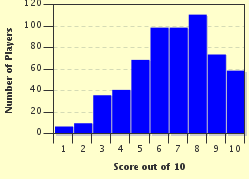Quiz Answer Key and Fun Facts
1. Which K is a sign of meningitis or meningeal irritation?
2. Which L is found between the frontal temporal lobes of the brain?
3. Which M is the lowest part of the brain stem?
4. N is for which supporting and insulating cells around neurones in the central nervous system?
5. Which structure contains the sensitive nerve terminals in the inner ear?
6. The autonomic nervous system controls the visceral functions of the body. Which P is a major subdivision of this system?
7. We'll skip Q and go to R.
What is a 'knee-jerk'?
8. Which S is the space between the axon of one neurone with the dendrites of another?
9. Which T is the important mass of nerve cells located in the very centre of the brain?
10. We'll pass U and move on to V, which is the end of our quiz.
Which V is an agent or nerve that affects the calibre of blood vessels?
Source: Author
leith90
This quiz was reviewed by FunTrivia editor
crisw before going online.
Any errors found in FunTrivia content are routinely corrected through our feedback system.


